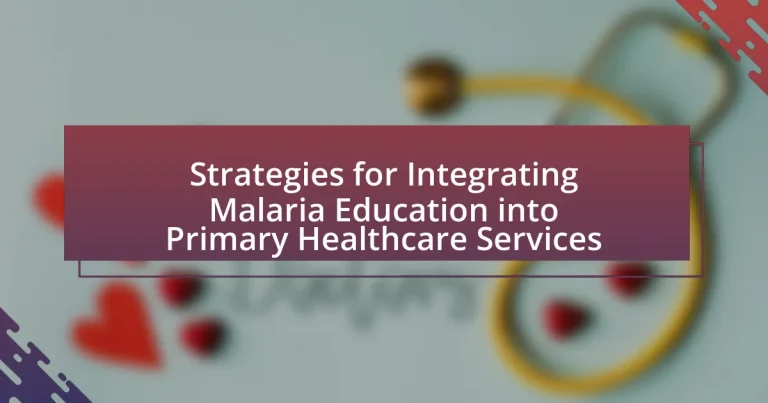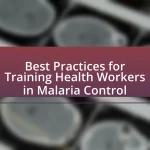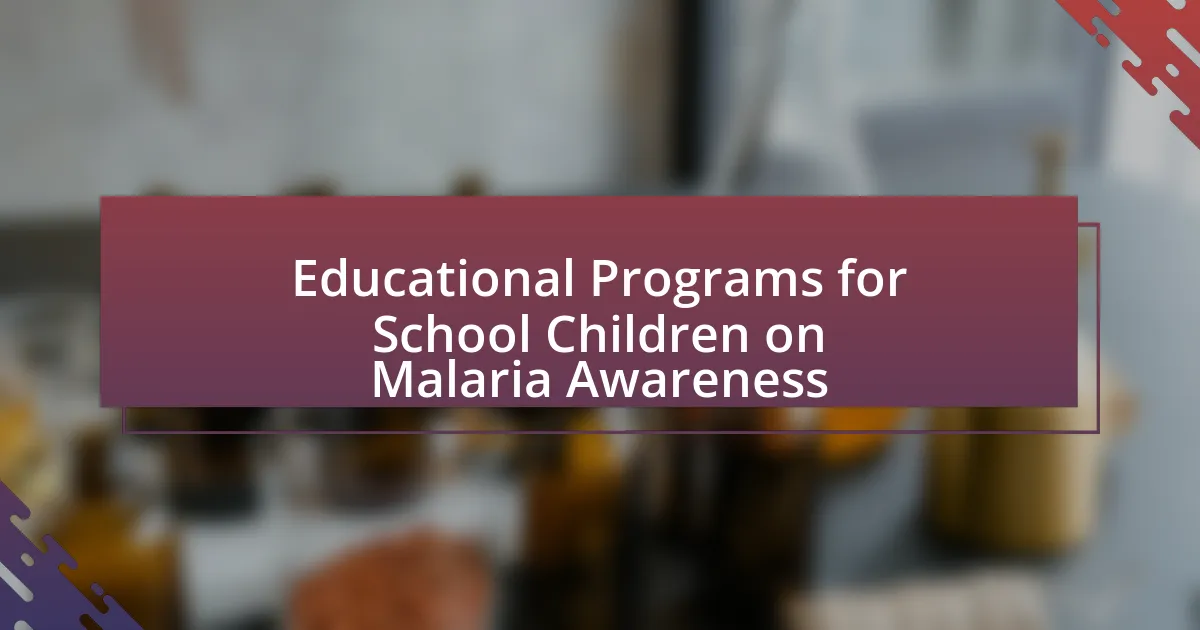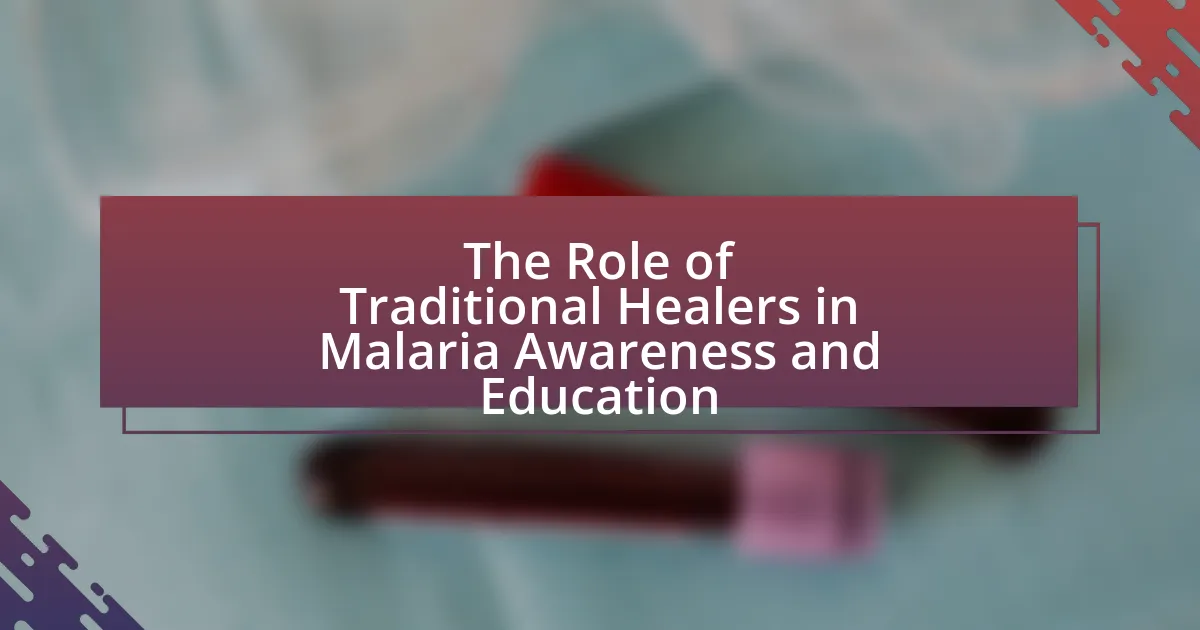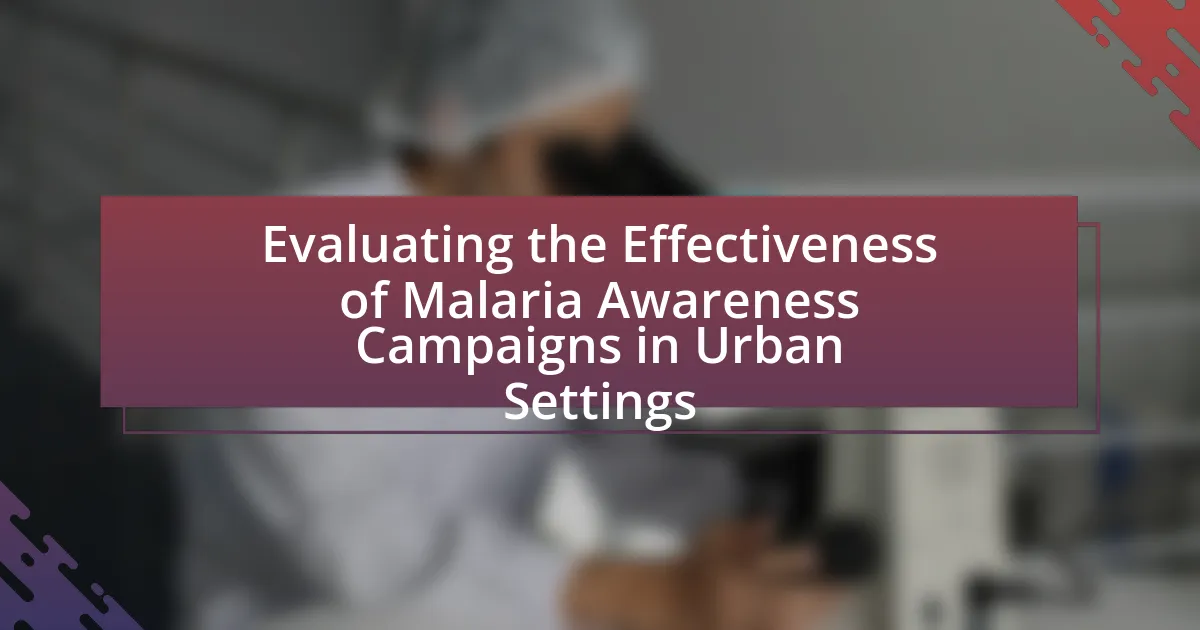The article focuses on strategies for integrating malaria education into primary healthcare services, emphasizing the importance of training healthcare providers, developing community outreach programs, and utilizing culturally tailored educational materials. Key methods for effective delivery of malaria education include community engagement, routine integration into healthcare services, and the use of visual aids. The role of community health workers is highlighted as essential for bridging gaps in knowledge and promoting preventive measures. Additionally, the article discusses challenges such as resource limitations and cultural misconceptions, while proposing innovative solutions and best practices to enhance the effectiveness of malaria education initiatives.
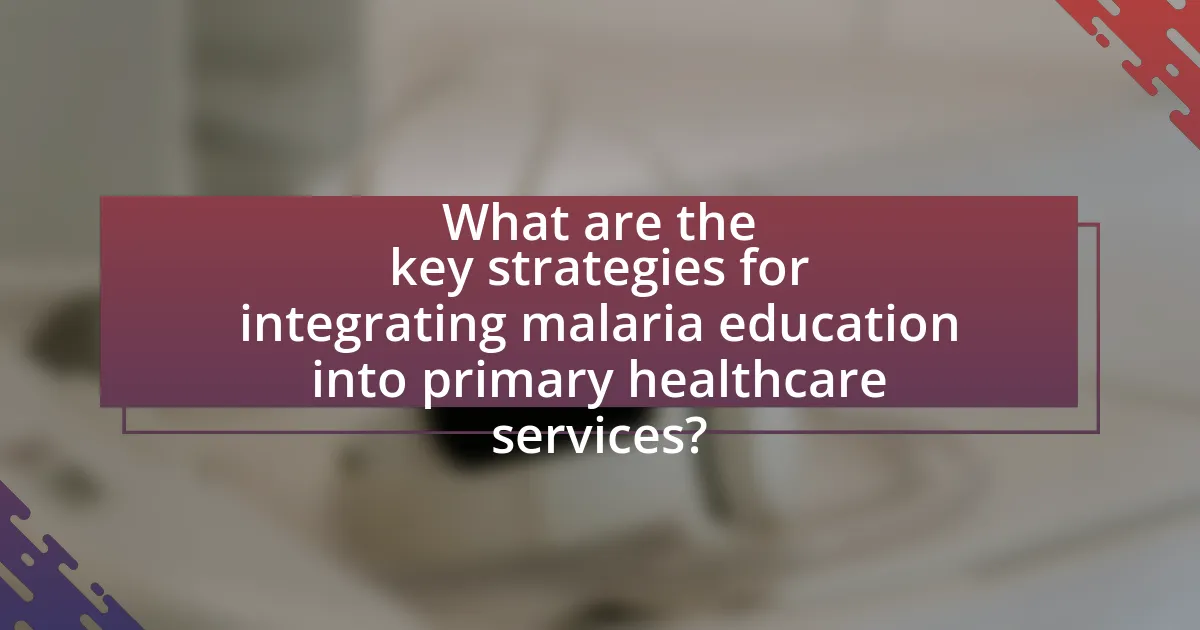
What are the key strategies for integrating malaria education into primary healthcare services?
Key strategies for integrating malaria education into primary healthcare services include training healthcare providers, developing community outreach programs, and utilizing educational materials tailored to local contexts. Training healthcare providers ensures they have the knowledge to educate patients effectively about malaria prevention and treatment. Community outreach programs engage local populations, raising awareness and promoting preventive measures such as the use of insecticide-treated nets. Tailored educational materials, which consider cultural and linguistic factors, enhance understanding and retention of information. These strategies are supported by evidence showing that effective education can significantly reduce malaria incidence and improve health outcomes in affected regions.
How can primary healthcare providers effectively deliver malaria education?
Primary healthcare providers can effectively deliver malaria education by utilizing community engagement strategies, integrating educational materials into routine healthcare services, and employing culturally relevant communication methods. Engaging the community fosters trust and encourages participation, which is essential for effective education. For instance, studies show that community health workers can significantly improve knowledge and preventive practices regarding malaria when they are involved in educational outreach. Additionally, incorporating malaria education into regular health check-ups ensures that patients receive consistent information, reinforcing the importance of prevention and treatment. Culturally relevant communication, such as using local languages and addressing specific community beliefs about malaria, enhances understanding and retention of information, leading to better health outcomes.
What training is necessary for healthcare providers to teach malaria education?
Healthcare providers require specialized training in malaria epidemiology, prevention strategies, and treatment protocols to effectively teach malaria education. This training should include understanding the life cycle of the malaria parasite, recognizing symptoms, and knowing the importance of preventive measures such as insecticide-treated nets and antimalarial medications. Additionally, providers should be trained in community engagement techniques to effectively communicate and educate the public about malaria risks and prevention. Evidence from the World Health Organization indicates that healthcare providers equipped with comprehensive malaria education can significantly improve community awareness and reduce malaria incidence.
How can healthcare providers assess the effectiveness of malaria education delivery?
Healthcare providers can assess the effectiveness of malaria education delivery by utilizing pre- and post-education surveys to measure knowledge retention and behavior change among participants. These surveys can include specific questions about malaria transmission, prevention methods, and treatment options, allowing providers to quantify improvements in understanding. For instance, a study published in the Malaria Journal demonstrated that implementing structured educational interventions resulted in a 40% increase in knowledge scores among community members. Additionally, healthcare providers can track changes in malaria incidence rates in the community following educational initiatives, providing a direct correlation between education and health outcomes.
What role do community health workers play in malaria education?
Community health workers play a crucial role in malaria education by serving as a bridge between healthcare systems and communities. They provide essential information about malaria prevention, symptoms, and treatment options, which is vital for reducing transmission rates. Studies have shown that community health workers can significantly increase knowledge and awareness of malaria in their communities, leading to improved health-seeking behaviors. For instance, a systematic review published in the “American Journal of Tropical Medicine and Hygiene” found that community health worker-led interventions resulted in a 30% increase in the use of insecticide-treated nets and a 25% increase in prompt treatment-seeking for malaria symptoms. This evidence underscores the effectiveness of community health workers in enhancing malaria education and ultimately contributing to better health outcomes.
How can community health workers be trained to educate about malaria?
Community health workers can be trained to educate about malaria through structured training programs that include comprehensive curricula on malaria transmission, prevention, and treatment. These programs should incorporate interactive methods such as workshops, role-playing, and community engagement activities to enhance understanding and retention of information. Evidence shows that training community health workers with a focus on local malaria epidemiology and culturally relevant practices significantly improves their effectiveness in educating communities. For instance, a study published in the American Journal of Tropical Medicine and Hygiene demonstrated that targeted training increased knowledge and community outreach effectiveness by over 50%.
What strategies can be used to engage communities in malaria education?
To engage communities in malaria education, strategies such as participatory workshops, community health worker training, and the use of local media can be effectively implemented. Participatory workshops allow community members to actively engage in discussions about malaria prevention and treatment, fostering a sense of ownership and responsibility. Training community health workers equips them with the knowledge to disseminate accurate information and address local misconceptions about malaria. Utilizing local media, including radio and social media platforms, ensures that educational messages reach a broader audience, leveraging familiar communication channels to enhance understanding and awareness. These strategies have been shown to improve community knowledge and practices regarding malaria, as evidenced by studies indicating increased awareness and behavior change in areas where such initiatives were implemented.
Why is integrating malaria education important in primary healthcare?
Integrating malaria education into primary healthcare is crucial because it enhances awareness and prevention strategies among communities, leading to reduced transmission rates. Effective education empowers individuals to recognize symptoms, understand transmission methods, and adopt preventive measures such as using insecticide-treated nets and seeking timely medical care. According to the World Health Organization, countries that implemented comprehensive malaria education programs saw a significant decrease in malaria cases, demonstrating the direct impact of informed communities on public health outcomes.
What impact does malaria education have on community health outcomes?
Malaria education significantly improves community health outcomes by increasing awareness and understanding of prevention and treatment methods. Studies show that communities with effective malaria education programs experience reduced incidence rates, as individuals are more likely to adopt preventive measures such as using insecticide-treated bed nets and seeking timely medical care. For instance, a study published in the American Journal of Tropical Medicine and Hygiene found that malaria education led to a 30% decrease in malaria cases in regions where such programs were implemented. This evidence highlights the critical role of education in empowering communities to combat malaria effectively.
How does malaria education contribute to the overall healthcare system?
Malaria education significantly enhances the overall healthcare system by improving awareness, prevention, and treatment of the disease. Educated communities are more likely to adopt preventive measures, such as using insecticide-treated bed nets and seeking timely medical care, which reduces malaria transmission rates. For instance, a study published in the American Journal of Tropical Medicine and Hygiene found that malaria education programs led to a 50% reduction in malaria cases in targeted populations. This reduction alleviates the burden on healthcare facilities, allowing them to allocate resources more effectively and improve overall health outcomes. Furthermore, increased knowledge about malaria fosters community engagement and empowers individuals to participate in public health initiatives, thereby strengthening the healthcare system as a whole.
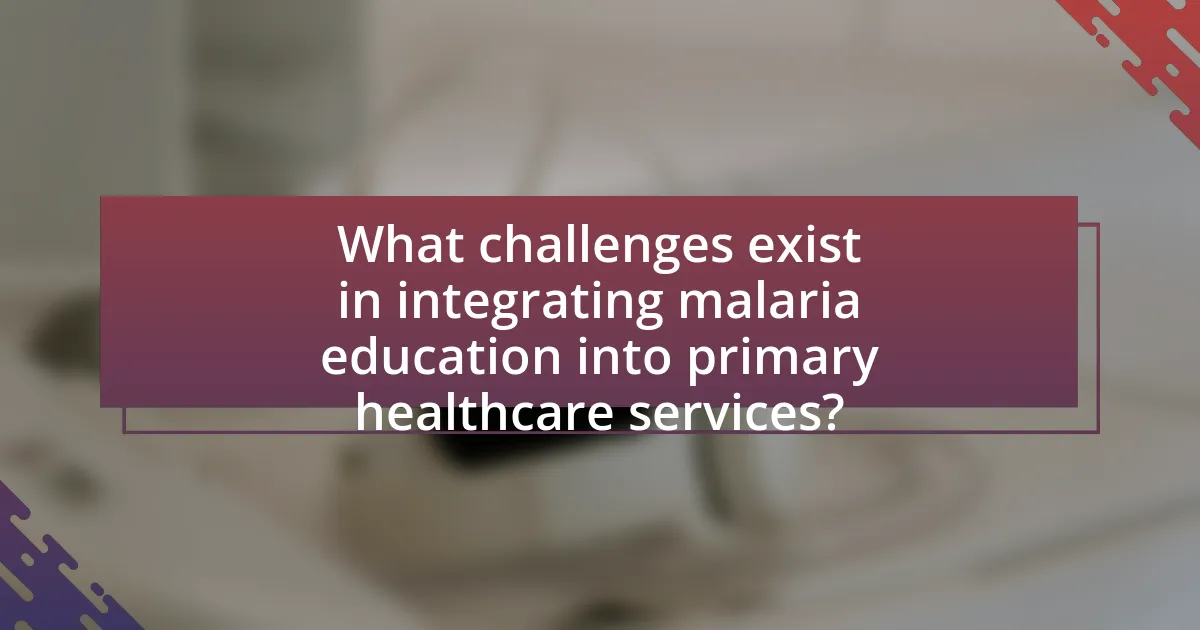
What challenges exist in integrating malaria education into primary healthcare services?
Integrating malaria education into primary healthcare services faces several challenges, including limited resources, inadequate training of healthcare providers, and lack of community engagement. Limited resources hinder the development and dissemination of educational materials, while inadequate training results in healthcare providers being ill-equipped to effectively communicate malaria prevention and treatment strategies. Furthermore, lack of community engagement can lead to low awareness and acceptance of malaria education initiatives, ultimately reducing their effectiveness. These challenges are supported by studies indicating that successful integration requires addressing these barriers to enhance knowledge and improve health outcomes related to malaria.
What barriers do healthcare providers face in delivering malaria education?
Healthcare providers face several barriers in delivering malaria education, including limited resources, inadequate training, and cultural misconceptions. Limited resources, such as insufficient funding and lack of educational materials, hinder the ability to effectively disseminate information. Inadequate training among healthcare providers can lead to a lack of confidence in delivering accurate malaria education. Cultural misconceptions about malaria, including beliefs about its causes and treatment, can further complicate communication efforts. These barriers collectively impede the effectiveness of malaria education initiatives within primary healthcare services.
How can resource limitations affect malaria education efforts?
Resource limitations significantly hinder malaria education efforts by restricting access to essential materials and trained personnel. For instance, inadequate funding can lead to a lack of educational resources such as pamphlets, visual aids, and digital content, which are crucial for effective communication about malaria prevention and treatment. Additionally, limited financial resources often result in insufficient training for healthcare workers, reducing their ability to educate communities effectively. According to the World Health Organization, countries with constrained healthcare budgets face challenges in implementing comprehensive malaria education programs, which can lead to higher transmission rates and poorer health outcomes.
What cultural factors may hinder effective malaria education?
Cultural factors that may hinder effective malaria education include traditional beliefs, language barriers, and social norms. Traditional beliefs may lead communities to attribute malaria to supernatural causes rather than biological factors, reducing the perceived importance of preventive measures. Language barriers can prevent clear communication of malaria information, especially in multilingual regions, making it difficult for individuals to understand prevention and treatment options. Social norms, such as gender roles, may limit women’s access to healthcare resources or decision-making power regarding health practices, further complicating malaria education efforts. These factors collectively impede the dissemination and acceptance of malaria education, as evidenced by studies showing that culturally tailored interventions significantly improve health outcomes in affected communities.
How can these challenges be overcome?
To overcome the challenges of integrating malaria education into primary healthcare services, targeted training programs for healthcare providers must be implemented. These programs should focus on enhancing knowledge about malaria prevention, symptoms, and treatment protocols, ensuring that healthcare workers can effectively educate patients. Evidence from the World Health Organization indicates that training healthcare providers significantly improves patient outcomes and increases community awareness of malaria. Additionally, incorporating community engagement strategies, such as local workshops and outreach initiatives, can further enhance understanding and acceptance of malaria education within the community. This dual approach of training and community involvement has been shown to increase the effectiveness of health education campaigns, as demonstrated in various studies across malaria-endemic regions.
What innovative solutions can be implemented to enhance malaria education?
Innovative solutions to enhance malaria education include the integration of mobile health applications that provide real-time information and resources about malaria prevention and treatment. These applications can deliver tailored educational content based on user demographics and geographic location, ensuring that the information is relevant and accessible. For instance, a study published in the Journal of Medical Internet Research found that mobile health interventions significantly improved knowledge and awareness of malaria among users in endemic regions. Additionally, incorporating gamification techniques into educational programs can engage younger audiences, making learning about malaria prevention more interactive and effective. Research from the World Health Organization indicates that interactive learning methods can lead to better retention of information, ultimately contributing to improved health outcomes.
How can partnerships with NGOs improve malaria education integration?
Partnerships with NGOs can significantly enhance malaria education integration by leveraging their local knowledge and established community trust. NGOs often have direct access to vulnerable populations, enabling them to tailor educational programs that resonate with community needs and cultural contexts. For instance, a study by the World Health Organization found that community-based interventions led by NGOs increased malaria awareness by 40% in targeted regions. This localized approach ensures that educational content is relevant and effectively communicated, ultimately improving health outcomes and fostering sustainable practices in malaria prevention and treatment.
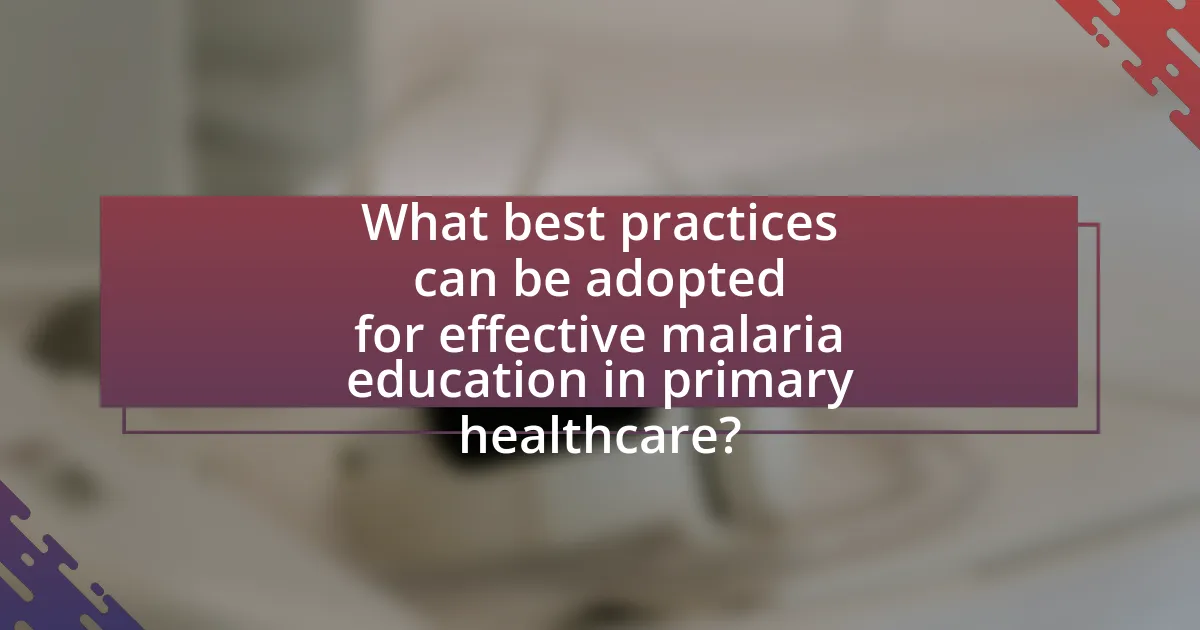
What best practices can be adopted for effective malaria education in primary healthcare?
Effective malaria education in primary healthcare can be achieved through community engagement, culturally relevant materials, and continuous training for healthcare providers. Community engagement fosters trust and encourages participation, as evidenced by programs that involve local leaders and organizations, which have shown increased awareness and prevention practices. Utilizing culturally relevant educational materials ensures that information resonates with the target population, enhancing understanding and retention; studies indicate that tailored messages significantly improve health literacy. Continuous training for healthcare providers is essential to keep them updated on the latest malaria research and treatment protocols, which has been linked to improved patient outcomes and adherence to guidelines.
What methods are most effective for teaching malaria prevention and treatment?
The most effective methods for teaching malaria prevention and treatment include community-based education, interactive workshops, and the use of visual aids. Community-based education engages local populations through tailored messaging that resonates with cultural beliefs and practices, leading to higher retention of information. Interactive workshops allow participants to practice preventive measures, such as using insecticide-treated nets and recognizing symptoms of malaria, which enhances understanding and application of knowledge. Visual aids, such as posters and videos, effectively convey information about malaria transmission and prevention strategies, making complex concepts more accessible. Research indicates that these methods significantly improve knowledge and behavior regarding malaria prevention and treatment, as evidenced by studies showing increased net usage and treatment-seeking behavior in communities that implemented these educational strategies.
How can visual aids and technology enhance malaria education?
Visual aids and technology can significantly enhance malaria education by improving comprehension and retention of information. For instance, interactive presentations and infographics can simplify complex data about malaria transmission and prevention, making it more accessible to diverse audiences. Research indicates that visual learning can increase information retention by up to 65%, compared to traditional text-based methods. Additionally, mobile applications and online platforms can provide real-time updates and resources, facilitating continuous learning and engagement. By integrating these tools into primary healthcare services, educators can effectively reach and inform communities about malaria, ultimately leading to better health outcomes.
What role does patient feedback play in improving malaria education methods?
Patient feedback is crucial in enhancing malaria education methods by providing insights into the effectiveness and relevance of educational content. This feedback allows healthcare providers to tailor malaria education to meet the specific needs and understanding of patients, ensuring that the information is accessible and actionable. For instance, studies have shown that incorporating patient perspectives can lead to improved comprehension and retention of information, ultimately resulting in better health outcomes. By actively engaging patients in the evaluation of educational strategies, healthcare systems can identify gaps in knowledge and adjust their approaches accordingly, thereby fostering a more informed community capable of preventing and managing malaria effectively.
How can ongoing evaluation improve malaria education initiatives?
Ongoing evaluation can significantly enhance malaria education initiatives by providing continuous feedback on program effectiveness and participant engagement. This process allows educators to identify strengths and weaknesses in their teaching methods and materials, ensuring that the content remains relevant and impactful. For instance, studies have shown that programs incorporating regular assessments can adapt to the evolving understanding of malaria transmission and prevention, leading to improved knowledge retention among participants. Furthermore, ongoing evaluation facilitates data collection on community needs and preferences, which can inform tailored educational strategies that resonate with diverse populations. This adaptability is crucial, as evidenced by the World Health Organization’s recommendation for regular monitoring and evaluation to optimize health education interventions.
What metrics should be used to evaluate the success of malaria education programs?
To evaluate the success of malaria education programs, key metrics include knowledge retention, behavior change, and incidence rates of malaria. Knowledge retention can be assessed through pre- and post-program surveys that measure participants’ understanding of malaria transmission, prevention, and treatment. Behavior change can be evaluated by monitoring the adoption of preventive measures, such as the use of insecticide-treated nets and indoor residual spraying, through follow-up interviews or observational studies. Additionally, a reduction in malaria incidence rates in the target population serves as a critical indicator of the program’s effectiveness, as evidenced by data from health surveillance systems that track malaria cases over time.
How can continuous training for healthcare providers enhance malaria education?
Continuous training for healthcare providers enhances malaria education by ensuring that they remain updated on the latest research, treatment protocols, and prevention strategies. This ongoing education equips healthcare professionals with the necessary knowledge to effectively diagnose and manage malaria cases, which is crucial in regions where the disease is endemic. For instance, a study published in the “American Journal of Tropical Medicine and Hygiene” found that healthcare workers who participated in continuous training programs demonstrated a 30% increase in their ability to correctly identify malaria symptoms and recommend appropriate treatments. This improvement directly correlates with better patient outcomes and increased community awareness about malaria prevention and control measures.
What practical tips can healthcare providers implement for effective malaria education?
Healthcare providers can implement several practical tips for effective malaria education, including utilizing community health workers to disseminate information, integrating malaria education into routine healthcare visits, and employing visual aids and culturally relevant materials. Community health workers can bridge the gap between healthcare systems and communities, ensuring that accurate information reaches those at risk. Integrating malaria education into routine visits allows for consistent messaging and reinforces the importance of prevention and treatment. Visual aids, such as posters and brochures, along with culturally relevant materials, enhance understanding and retention of information, making it more accessible to diverse populations. These strategies are supported by evidence indicating that community engagement and tailored educational approaches significantly improve knowledge and preventive behaviors regarding malaria.
